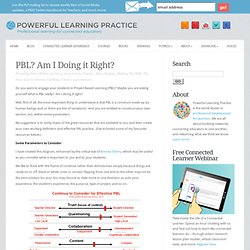

Thinking skills. Questioning. Project based learning. Do you want to engage your students in Project Based Learning (PBL)?

Maybe you are asking yourself what is PBL really? Am I doing it right? Well, first of all, the most important thing to understand is that PBL is a construct made up by human beings and so there are lots of variations! And you are entitled to construct your own version, too, within some parameters. My suggestion is to study many of the great resources that are available to you and then create your own working definition and effective PBL practice.
Some Parameters to Consider I have created this diagram, enhanced by the critical eye of Brenda Sherry, which may be useful as you consider what is important to you and to your students. We like to think with the frame of continua rather than dichotomies simply because things are rarely on or off, black or white, ones or zeroes! You could likely add other dimensions to consider as you build your own understandings and beliefs! Trust Who is in control? Questioning Collaboration. Classroom atmosphere scale. The scale was devised to encourage trainee teachers to think about the degree to which teachers are in relaxed and assured control of their classrooms and can enjoy their teaching, and also, the extent to which there is a ‘right to learn' for pupils, free from the noise and disruption of others.

It is not designed as an instrument to pass judgement on the class management skills of teachers (not least because there are so many other variables which influence the levels – most obviously, which school you are working in). Its purpose is to get trainee teachers (and teachers, departments and schools) to think about the factors influencing the working atmosphere in the classroom, the influence of the working atmosphere in classrooms on teaching and learning, and the equal opportunities issues surrounding the tension between inclusion, and situations where some pupils may be spoiling the learning of others.
‘I cannot stress how wonderful it is to teach a well behaved class. (Trainee)
Assessment / Feedback. Metaphors and analogies. Pace and depth of learning — From Good to Outstanding: Helping you to achieve outstanding and creative teaching and learning. When evaluating the quality of teaching in the school, inspectors must consider: “the extent to which the pace and depth of learning are maximised as a result of teachers’ monitoring of learning during lessons and any consequent actions in response to pupils’ feedback” (Ofsted evaluation schedule January 2012) The above reference to ‘Pace and depth’ of learning in the January Ofsted framework, on which this set of posts was originally based , is not included in the latest (September 2012) Handbook for school inspection.

It is mystery (to me anyway) why it was removed, nevertheless I suspect it remains a fundamental part of the judgment process and as I believe that pace and depth of learning are inseparable from progress, I decided to do the post anyway. Pace: When referring to ‘pace’ the main thing to bear in mind is: Pace is not the same as speed! Teachers certainly have a sense of the speed at which learning needs to take place in order to successfully complete a course of learning. Jivespin's Space - Jivespin's History resources. Critiquing. Easy walkthroughs. Building Learning Power.